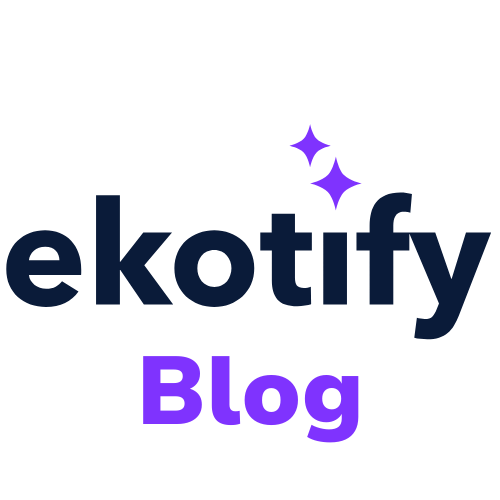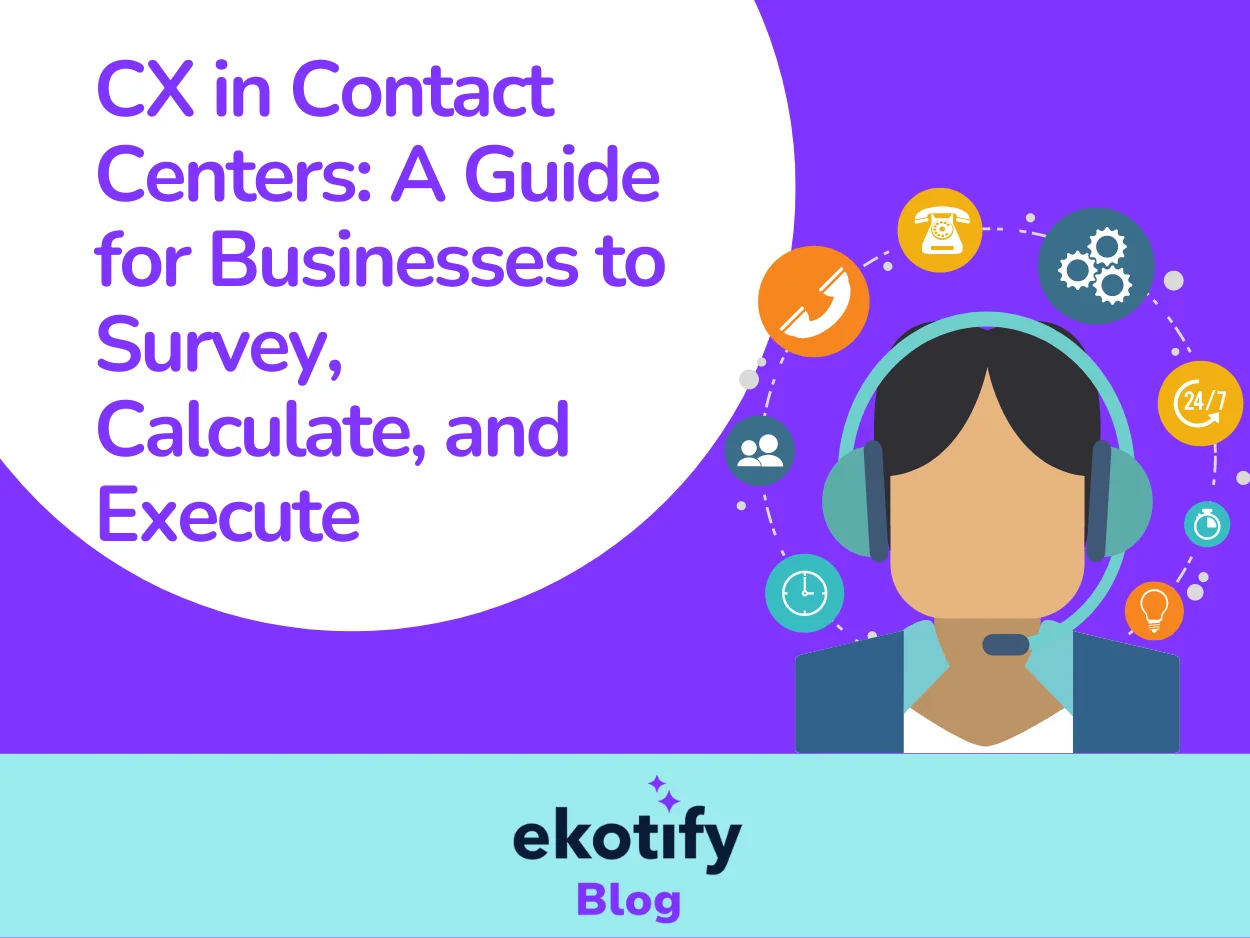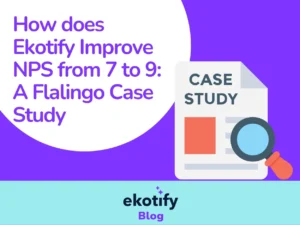To define CX (Customer Experience), we emphasize that all departments in the business are responsible for elevating customer satisfaction. However, our discussion topic is CX in the contact centers, which may seem somewhat contradictory given our initial standpoints.
Even though every department should adopt a customer-focused approach for the sake of CX, the contact center is at the heart of it as it is in direct touch with the users. Still, CX in the contact center is not an easy task as the term first suggests. The contact center is where businesses are able to serve and calculate CX.
Therefore, as contact centers are entitled to direct communication with customers, they have more impact on making customers content and providing the data to measure CX. Based on these functions, we provide a guide for businesses on how to regard CX and understand where it stands on customer journey. After that we will talk about which metrics to consider and calculate, and finally how to execute a strategy to improve CX.
First Things First: What is CX?
CX is the way customers perceive their engagement and interaction with a brand throughout the pre-purchase, purchase, post-purchase, and repurchase processes.
How to Survey on CX?
Today, we are trying to measure CX by calculating key metrics to profile it, and then evaluating it by focusing on the shortfalls and leveraging the advantages. Not so fast! Achieving excellence in CX is one of the most advantageous investments for a business, but it is not easy to achieve. Before moving on to metrics and calculations, we should comprehensively handle the customer journey.
Understanding Customer Journey
We clarified that CX is a state of the customers’ mind that evolves over a time-consuming process. In short, we can say that a business can yield a positive customer experience as a result of the customer journey. Therefore, rushing into the data without simulating the customer journey would be an exercise in futility.
Simply yet sufficiently put, the pivotal aim of every business is to guide customers from the widest standpoint of the funnel to the point of payment. Narrowing the journey to the scope of a single business, we call it the “buyer journey.” For a successful arrival at your paywall, businesses should adopt a comprehensive map to ensure that no touchpoint is left to chance.
The Role of Contact Center in Customer Journey
One might wonder why we shift our focus to the customer journey when discussing contact centers and their role in CX. As stated, brands should safeguard their touchpoints to ensure customer satisfaction and achieve both short-term and long-term goals.
First, the customer journey maps all the interactions a person has with both competitors and your brand at various points, from awareness to post-purchase. Whenever your contact center interacts with the customer on this journey, it is an opportunity to improve their experience or identify deficiencies using key metrics and address them. Since the customer journey is where first impressions emerge and act as a building block for CX, particularly in the contact centers, it is essential for businesses to study and optimize it.
Second, with communication at every touchpoint, businesses have the chance to present a satisfying customer experience. Collecting customer feedback and measuring CX play a crucial role in growth, as they enable businesses to improve their strategies or implement groundbreaking ones.
Hence, a well-studied customer journey and well-gathered customer feedback aid businesses in taking immediate actions, such as improving communication channels, or developing long-term plans like eliminating pain points and developing strategies based on opportunities.
What Makes Measuring CX on Contact Centers So Important?
Before answering the question, it’s important to note that CX is a measurable outcome that encompasses more than just good or bad feedback. Returning to our question, measuring CX is crucial because customer behavior, needs, desires, expectations, satisfaction, and complaints are constantly evolving. Measuring CX is a foundational task for excelling in service quality. Before trying to improve the efficiency of a contact center, one must understand the current circumstances. Therefore, to identify what to improve, why to improve, and how to improve, businesses should be busy with CX in the contact centers.
A Brief Overview of Yardsticks for CX Measurement in Contact Centers
We have discussed that CX (Customer Experience) involves thoroughly understanding the mindset of our entire customer base. Evaluating your customer experience performance requires a detailed examination. In this section, we have listed the most utilized and foundational CX metrics. All these metrics share the same pivotal aim: to indicate the sentiment of customers. However, each focuses on different aspects of the CX.
What is NPS?
Net Promoter Score (NPS) is a metric that quantifies the proportion of customers who encourage others to use your service or product.
How to Calculate NPS Score?
NPS score is the simplest indicator of brand loyalty and the likelihood of acquiring new customers. The formula for NPS is simply: % promoters – % detractors. Even if you don’t have exact data right now, you can use a basic calculator to see how your brand is doing. Just try to remember the last time a customer mentioned that they would recommend your service to someone else. Instead of counting one by one, you can measure the likelihood.
Secondly, try to recall the last time a new customer mentioned that someone recommended your service to them. By estimating roughly, just insert the percentage into our calculator. This is the first step in improving your CX in the contact center.
What is CSAT
Customer Satisfaction (CSAT) is a metric that quantifies how satisfied customers are with a product or service.
How to Calculate CSAT?
Relatively easy to calculate yet highly impactful, the CSAT score measures the satisfaction level of customers. CSAT can be scored for a specific product or branch, as well as comprehensively. To see your brand’s CSAT score, you can use our calculator.
To calculate CSAT, you should first gather feedback. By asking customers how satisfied they are on a scale from 1 to 5, you can complete the first step. Then, add the numbers and divide by the number of respondents. By multiplying the result by 100, you can obtain the CSAT percentage.
However, as you may notice, this calculation is based on a conventional feedback-gathering system. Simply asking customers about your service quality before they end the call may skew the results. To avoid posing questions to customers and gathering hasty or biased answers, consider using new tools to collect feedback.
What is CES?
Customer Effort Score (CES) is a metric that quantifies the ease of using a business’s products and services for its customers.
How to Calculate CES?
Customer Effort Score (CES) indicates how convenient it is for customers to access your business for different purposes. A lower score means customers can interact with you easily and quickly. Conversely, higher scores suggest the need for improvements to prevent customer frustration and churn. By identifying where customers encounter friction through higher CES scores, you can swiftly execute strategies to eliminate these issues.
There are three different scales to measure CES:
- Likert Scale: This method works as a survey, asking customers about their satisfaction with the ease of accessing specific channels or services. On the Likert scale, customers rate their experience between two extreme ends.
- Numeric Scale: This scale measures the satisfaction score that a customer gives based on the effort required. Customers provide a score, which is more particularized.
- Emotion Scale: This scale asks customers about their happiness, reflecting their experiences with emojis.
However, these three popular scales rely on the deliberate action of the customer to provide feedback. While this method has its benefits, it also has disadvantages. Consider the last time a brand asked you to evaluate their performance. Even though it only takes seconds, it can be frustrating. To avoid pushing customers to evaluate brand performance, consider switching to more customer- and business-friendly feedback solutions.
To calculate the CES score, take all the scores you have gathered and divide them by the number of respondents. Be sure to calculate each scale separately.
What is FRC?
First Call Resolution (FCR) is a metric that quantifies the problem-solving capability of a contact center on the first interaction.
How to Measure FCR?
FCR, also known as “first touch resolution” and “first call resolution,” refers to when a contact center resolves a customer’s problem in a single interaction. This metric indicates the problem-solving capability of a business and, therefore, its CX success.
To measure how solution-focused your company is, divide the number of problems solved on the first contact by the number of solution-demanding contacts, then multiply by 100. This calculation will give you your FCR performance as a percentage.
If you do not have the exact data now, consider the number of complaints on various corners of the internet. Recurring negative customer evaluations online often indicate low FCR capability, as customers use these platforms to amplify their voices and prompt your contact center to take action.
What is CLV?
Customer Lifetime Value (CLV) is a metric that quantifies the total revenue a business receives throughout the lifetime of a customer.
How to Calculate Customer Lifetime value (CLV)?
CLV is a metric that estimates the total revenue a business can acquire from a single customer. Unlike the previous metrics we covered, CLV is more straightforward in measuring the impact of a customer on profit. For example, statistics show that acquiring new customers can be 5 to 25 times more costly than retaining existing ones. Therefore, measuring customer lifetime value can help businesses pinpoint contact center success, take precautions against churn, and execute strategies to foster customer loyalty.
CLV comes with two models; first, predictive and second is historical. As the second one relies on the previous data, the first model predicts the CVL based on machine learning. To calculate historical CLV, one can use CLV=Average Purchase Value×Average Purchase Frequency×Customer Lifespan formula. Let’s clarify this formula step by step:
Note: Don’t worry; in further sections, we will talk about churn rate and how to calculate it.
As we said, Predictive CLV relies on statistical models and machine learning. Predictive CVL helps businesses to simulate the future of the customer-contact center-brand relation. To calculate your highly-likely future CVL;
CLV = ∑ (E(Mₜ) × E(Cₜ)) / (1 + d)ᵗ
Where:
one can use this formula.
What is AHT?
Average Handle Time (AHT) is a metric that quantifies the average duration an agent takes to finalize a contact, from answering the call to completing the last notes.
How to Calculate Average Handle Time (AHT)?
As it is self-explanatory, Average Handle Time (AHT) is one of the cornerstone metrics employed to measure the average duration of calls and to show the efficiency of contact centers. This average handle time covers the hold time, conversation period, and other tasks that agents should complete after the call is concluded. Calculating the average time that an agent takes to conclude a call helps contact centers find the AHT sweet spot, where efforts meet customer experience.
Calculating AHT is straightforward. First, add your total conversation duration, total hold time, and total after-call tasks. Then, divide the sum by the number of calls you receive.
What is Call Abandonment Rate?
The Call Abandonment Rate is a metric that quantifies the percentage of calls terminated by customers when the contact center fails to respond.
How to Calculate Call Abandonment Rate?
The call abandonment rate reflects on the customer experience (CX) in contact centers. A high call abandonment rate means unhappy customers. To be frank, businesses should not feel content about the call abandonment rate unless it is zero.
Calculating the call abandonment rate of a contact center is simple. Take all the abandoned calls, divide them by all incoming calls, and multiply by one hundred.
Caution: Do not confuse abandoned calls with:
- Short calls: where a caller hangs up immediately.
- Dropped calls: calls cut due to a technical problem.
- Missed calls: calls that a contact center deliberately disconnects due to a limit set in the system.
Hint: Identify the reasons behind the call abandonment rate. Fixing the work schedule of the contact center can greatly reduce frustrated and abandoned calls, improve customer happiness, and provide a better first impression.oned calls and improve customer happiness; at least, it provides a faultless first impression.
What is Customer Retention Rate?
Customer Retention Rate is a metric that quantifies the percentage of customers who make repeat purchases over a given period.
How to Calculate Customer Retention Rate?
As discussed earlier, retention is the most powerful means of heading towards profit, as we all agree that acquiring new customers is costly. Keeping the retention rate at its peak is the ultimate aim of businesses with a promising customer experience (CX). A competitive CX is also a derivative of contact center success.
To calculate the Customer Retention Rate, you first need to specify a period. Do you want to calculate the monthly, bimonthly, or annual retention rate? Then, exclude newly acquired customers from the user pool. Next, divide the number of retained customers by the total number of customers, both old and new, at the beginning of the chosen period. Finally, multiplying this by one hundred will give you the customer retention rate.
What is Customer Churn Rate?
Customer Churn Rate is a metric that quantifies the percentage of customers who stop making purchases over a given period.
How to Customer Calculate Churn Rate
Bidding farewell to your customers is not as agonizing as facing the reality that your business does not provide your customers with a heartwarming customer experience (CX). One can say that churning customers are a blessing in disguise, as they help businesses detect what is wrong, where it is wrong, and how it is wrong. However, to fix the problems leading to churning and thus fix the churn rate, businesses should not just wait. Instead, before seeing high churn rates, it is possible to prevent customers from giving up on you with more sophisticated customer feedback gathering and analysis tools.
To calculate your customer churn rate, remember that it is never too late to mend. With that in mind, you should apply these easy steps:
First, define the time period. Then, determine the number of customers at the beginning of this time period. Next, determine the number of customers that stop purchasing by the end of the period. Divide this number by the number of customers at the beginning of the chosen period. Lastly, by multiplying the result by one hundred, you can calculate your customer churn rate.
In Sum;
It is not a hyperbole to say that CX thrives through successful, well-arranged contact centers. From the first impression to the moment of churn, the contact center is the Picasso of a brand’s growth with the customer. In this piece, we examined six key metrics, defined simply and calculated in detail. However, to execute the best strategies, businesses should delve deeper into key metrics. This calls for revolutionary CX management and contact center refinement tools, as there is much more hidden in the voice of the customers.




